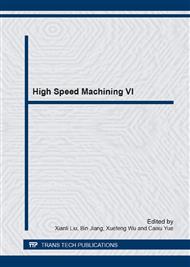[1]
X. Yan, H.M. Shi and A.M. Tang, New method for establishing the theory of metal cutting tool geometry design, J. Cemented Carbide. 17(02) (2000) 101~103.
Google Scholar
[2]
H.M. Shi, Metal Cutting Theory and Practice - a New Perspective, Huazhong University of Science & Technology Press, Wuhan, (2002).
Google Scholar
[3]
J.H. Liu, Theory and practice of Cutting Tool Precision Design, National Defence Industry Press, Beijing, (2005).
Google Scholar
[4]
H. Jiang, Application of cutting tool design by using Rota function, J. Tool Engineering. 24(10) (1990) 22~24.
Google Scholar
[5]
R.Y. Cheng, Principles of metal cutting, China Machine Press, Beijing, (2002).
Google Scholar
[6]
J. Bailey, R. Roy, et al, Cutting Tool Design Knowledge Capture, Springer, London, (2001).
Google Scholar
[7]
V. P. Astakhov, Fundamentals of the Selection of Cutting Tool Geometry Parameters, Springer, London, (2010).
Google Scholar
[8]
F. Klovke, A. Kuchle, Cutting Tool Materials and Tools, Springer, Berlin Heidelberg, (2011).
Google Scholar
[9]
C. Siemers, et al. Chip formation and machinability of nickel-base superalloys, C. Euro Superalloys 2010, P.O. Box 1254, Clausthal -Zellerfeld, D-38670, Germany, Trans Tech Publications, c2011: 460-465.
DOI: 10.4028/www.scientific.net/amr.278.460
Google Scholar
[10]
Y.H. Lu, Y.P. Zhu, Expert system in the design of complex shaped tools, J. Tool Engineering. (1988) 1~4.
Google Scholar
[11]
R.Z. Zhou, Application of cutting tool design by using NC automatic programming language, J. Tool Engineering. 06 (1984) 6~10.
Google Scholar
[12]
Y. Mizugaki, M. Hao, et al. Optimal tool selection based on genetic algorithm in a geometric cutting simulation, J. CIRP Annals - Manufacturing Technology. 43(1) (1994) 433-436.
DOI: 10.1016/s0007-8506(07)62247-1
Google Scholar
[13]
X.J. Hu, D.F. Chen, Application of Cutting tool design by computer simulation technology, J. Computer and Communications, 14(3) (1999) 55~57.
Google Scholar
[14]
B. Li, H. Zhang, et al. Numerical simulation technology on tool wear of metal cutting, C. International Conference on Advanced Technology of Design and Manufacture, ATDM 2010, November 23, 2010 - November 25, 2010, Beijing, China, Institution of Engineering and Technology, c2010: 225-231.
DOI: 10.1049/cp.2010.1294
Google Scholar
[15]
Y.J. Wang, C. Wu, X.T. Zhang, Research of auto-modeling of cutting tool machining turbine blade based on UG, J. Mechanical Engineer. 5 (2010) 103~105.
Google Scholar


